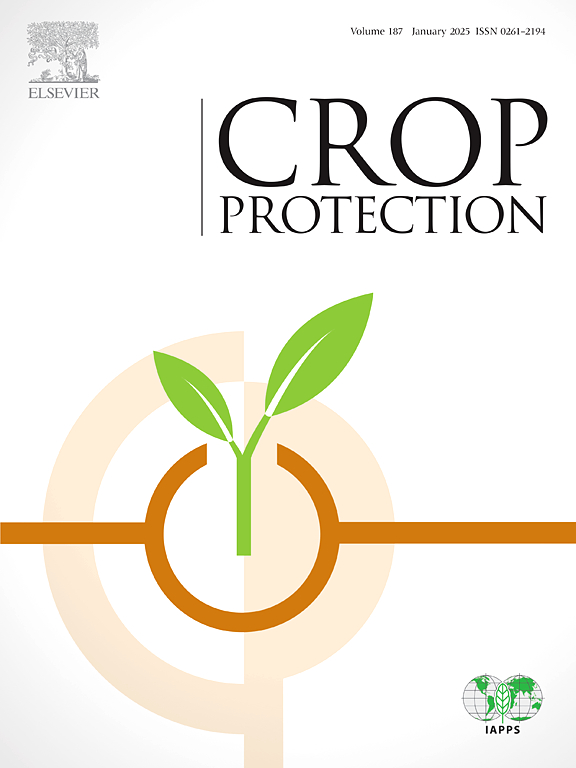引起李子采后腐果病的王氏芽孢菌、少女炭疽菌、Diaporthe eres和candidhum在国内首次报道
IF 2.5
2区 农林科学
Q1 AGRONOMY
引用次数: 0
摘要
李子(Prunus salicina)因其多样的风味和营养价值而受到高度重视,使其成为果汁和果酱等加工食品的重要成分,使其成为世界上最受欢迎的水果之一。然而,它们采后的保质期短,加上快速变质和腐烂,对保持水果质量和延长货架稳定性提出了重大挑战,给该行业造成了巨大的经济损失。本研究采用形态学和分子生物学相结合的方法,对主要产区李子病样进行病原鉴定和鉴定。鉴定了造成贵州李子采后果实腐烂的主要病原菌为王氏芽孢菌(Botryosphaeria wangensis)、淋巴炭疽菌(Colletotrichum nymphaeae)、炭疽菌(Diaporthe eres)和白土霉(Geotrichum candidum)。全面识别这些病原体对于制定有针对性的疾病管理策略至关重要。该研究为提高李子品质和延长工业货架稳定性,解决水果保鲜和经济可持续性的基本需求提供了重要见解。本文章由计算机程序翻译,如有差异,请以英文原文为准。
First report of Botryosphaeria wangensis, Colletotrichum nymphaeae, Diaporthe eres, and Geotrichum candidum causing postharvest fruit rot of plums (Prunus salicina) in China
Plums (Prunus salicina ) are highly valued for their diverse flavors and nutritional benefits, making them essential ingredients in processed foods such as juices and jams, making them one of the world's most popular fruits. However, their postharvest short shelf life, compounded by rapid deterioration and rot, presents significant challenges to maintaining fruit quality and extending shelf stability, resulting in substantial economic losses for the industry. This study employed both morphological and molecular biology approaches to identify and characterize pathogens from diseased plum samples collected in major production regions. Key pathogens responsible for postharvest fruit rot in plums in Guizhou, China, were identified as Botryosphaeria wangensis , Colletotrichum nymphaeae , Diaporthe eres , and Geotrichum candidum . The comprehensive identification of these causative agents is crucial for developing targeted disease management strategies. This research contributes crucial insights for enhancing plum quality and extending shelf stability in the industry, addressing essential needs in fruit preservation and economic sustainability.
求助全文
通过发布文献求助,成功后即可免费获取论文全文。
去求助
来源期刊

Crop Protection
农林科学-农艺学
CiteScore
6.10
自引率
3.60%
发文量
200
审稿时长
29 days
期刊介绍:
The Editors of Crop Protection especially welcome papers describing an interdisciplinary approach showing how different control strategies can be integrated into practical pest management programs, covering high and low input agricultural systems worldwide. Crop Protection particularly emphasizes the practical aspects of control in the field and for protected crops, and includes work which may lead in the near future to more effective control. The journal does not duplicate the many existing excellent biological science journals, which deal mainly with the more fundamental aspects of plant pathology, applied zoology and weed science. Crop Protection covers all practical aspects of pest, disease and weed control, including the following topics:
-Abiotic damage-
Agronomic control methods-
Assessment of pest and disease damage-
Molecular methods for the detection and assessment of pests and diseases-
Biological control-
Biorational pesticides-
Control of animal pests of world crops-
Control of diseases of crop plants caused by microorganisms-
Control of weeds and integrated management-
Economic considerations-
Effects of plant growth regulators-
Environmental benefits of reduced pesticide use-
Environmental effects of pesticides-
Epidemiology of pests and diseases in relation to control-
GM Crops, and genetic engineering applications-
Importance and control of postharvest crop losses-
Integrated control-
Interrelationships and compatibility among different control strategies-
Invasive species as they relate to implications for crop protection-
Pesticide application methods-
Pest management-
Phytobiomes for pest and disease control-
Resistance management-
Sampling and monitoring schemes for diseases, nematodes, pests and weeds.
 求助内容:
求助内容: 应助结果提醒方式:
应助结果提醒方式:


